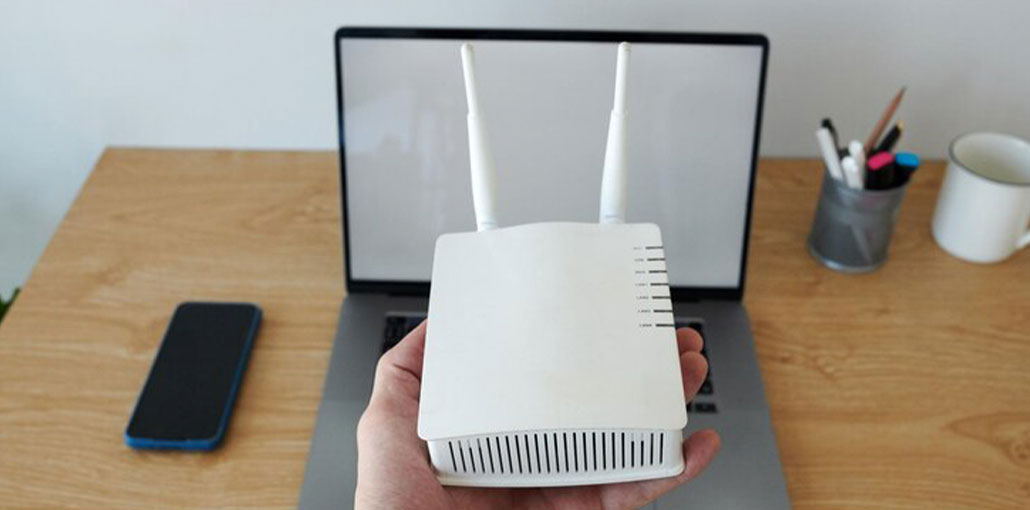If you’re a frequent traveler or someone who doesn’t endure poor hotel WiFi, A good travel router can transform the way you connect on the road. These small devices provide more than just keeping you connected. They also enhance weak signals, allowing you to connect several devices at once and usually feature features such as VPN support and media streaming, and even built-in batteries to provide real portability.
Some of the best travel routers on the market will completely change the way you connect abroad with fast and reliable connectivity over long distances, which can be as powerful as some of the traditional routers.
5 Best Travel Routers
1. GL-iNet Slate AX (AXT1800)
The Slate AX is well-respected for its ability to combine slim design and the power of Wi-Fi. It can reach speeds of around 600 Mbps at 2.4 GHz and 1200 Mbps at 5 GHz, thanks in part to its AX1800 rating. This is usually enough for daily streaming gaming or remote work.
It also runs an incarnation of OpenWrt that lets you add advanced features such as VPN and domain-based ad-blocking and a guest network. Three Gigabit Ethernet ports enable wired connectivity if Wi-Fi connectivity in your hotel suite isn’t functioning as expected or you want to set up a mini office inside it.
Pros:
- Supports Wi-Fi 6 for high-speed connectivity.
- Dual-band with up to 1800 Mbps throughput.
- VPN support built-in for secure browsing.
- Compact design, portable for travel.
- USB 3.0 port for external storage or tethering.
Cons:
- No internal battery; requires external power.
- Slightly more expensive than basic models (~$80).
Also read: 9 Best Laptops for Travel and Work
2. GL-iNet Barrel AX (GL-MT3000)
Barrel AX is a router for travel with 2 2.5 Gbps Ethernet ports, extremely rare in such a tiny device. If you find the fastest WAN available or enjoy connecting an NAS or other device with high speed, this is your opportunity.
Wi-Fi 6 compatibility means you’ll enjoy solid coverage and smooth multi-device performance, just like with its sibling Slate AX. Based on the OpenWrt OS, it also gives access to advanced options like routing, VPN setups, and plugins with just a few clicks away from being set up or managed.
Pros:
- High-speed Wi-Fi 6 support.
- VPN capable of secure connections.
- Dual-band for reliable connections.
- USB 3.0 port for added functionality.
Cons:
- Lacks an internal battery, needs external power.
- Higher price (~$100) compared to Slate AX for similar portability.
3. GL-iNet Mango (GL-MT300N)
The Mango is all about simplicity and low cost. It’s a one-band 2.4 GHz Wi-Fi that can reach up to 300 Mbps theoretical speed and 100Mbps Ethernet. On paper, it’s nothing extravagant. In reality, the only thing you need is a simple router that can unify all your devices under one SSID.
It’s still one of the most affordable ways to access VPN support while on the move with its reduced OpenWrt firmware. It can also be tethered to an iPhone or connect to a public hotspot using repeater mode. It’s incredibly small, smaller than most battery banks, and weighs nearly nothing.
Pros:
- Extremely compact and lightweight, very portable.
- Very affordable (~$25).
- VPN support included.
- Simple, easy-to-use interface.
Cons:
- Limited to Wi-Fi 4 (lower speeds).
- Less suitable for high-bandwidth activities (streaming, gaming).
- USB 2.0 only.
4. GL-iNet Opal (GL-SFT1200)
Opal is an excellent solution if you want an upgrade from single-band technology but aren’t move to Wi-Fi 6. It provides excellent coverage. This dual-band AC1200 travel router features three gigabit Ethernet ports and USB Type-C power input for convenient connectivity on the road.
Similar to other GL-iNet, it also includes VPN Tethering, VPN, along local file share. Dual-band speeds (up to 867 Mbps at 5 GHz, and 300 Mbps on 2.4 GHz) will be more than sufficient for streaming on Netflix and YouTube on your devices.
Pros:
- Compact and portable design.
- Wi-Fi 5 support, decent speed for most tasks.
- VPN support is included for privacy.
- Affordable (~$35).
Cons:
- No internal battery.
- USB 2.0 port only.
- Not as fast as Wi-Fi 6 models.
5. TP-Link AX1500
If brand recognition is essential, TP-Link’s AX1500 is a nifty Wi-Fi 6 router that offers up to 1500 Mbps in total throughput. It features 2 Gigabit Ethernet ports and a USB-C power connector, and internal antennas to create the most sleek travel footprint.
You can use an app on your phone to create it, which could be easier for beginners when compared to an OpenWrt-based interface. It also has a captive portal wizard that lets you sign in fast at hotels.
Pros:
- Wi-Fi 6 support for modern devices.
- VPN capability for secure connections.
- Reasonably priced (~$50).
- Easy setup with smartphone app.
Cons:
- Lacks advanced features found in GL.iNet models.
- No internal battery.
- Only 1 USB 2.0 port.
Also read: How to Choose The Right Online Booking System For Your Travel Business
6. Simo Solis 4G LTE Hotspot
It’s less of an actual travel router in the traditional sense, and more of a personal battery-powered hotspot that doesn’t have to track the local SIM cards. If you’re looking to avoid hotels with questionable networks entirely, Simo’s Solis could be a game-changer.
It generally offers 4G LTE in many regions, with data plans sold by the company, so you can connect up to 10 devices while on the move. The people who use it love the ease of use, particularly if they move from one place quickly, without having to deal with the local carrier.
Pros:
- Supports mobile data (4G LTE) anywhere.
- Internal battery for portability.
- Can act as a hotspot for multiple devices.
Cons:
- More expensive (~$150).
- No VPN support.
- Slower speeds during multiple devices are connected.
How to Select the Best Travel Router
Choosing the right travel router in the hotel may be a challenge. But don’t worry. I’m here for you. Let’s look at some of the things to keep in mind when picking the best router for you:
- Consider your travel needs. Determine your top priorities, such as security, portability, or solid connections. This will help reduce your options.
- Budget. Examine the cost averages of travel routers, and then set the budget. Numerous budget-friendly routers are available, but you must ensure that the router you choose comes with all the features you need.
- Special features. One key thing to keep in mind when searching for the ideal wifi for hotels is whether or not additional features like media streaming or file sharing will meet your requirements.
- Wi-Fi quality. Be aware of the Wi-Fi’s quality. Also, you should be prepared to deal with a weaker signal. I suggest purchasing a router that has extra support, such as signal boosters.
Key Takeaway
In 2025, we’ll see a wide range of travel routers according to your budgets and requirements. The affordable single-band models are still able to do the job for people with low Internet requirements, whereas new Wi-Fi 7 powerhouses, such as that of GL.iNet Slate 7, redefine what’s feasible on the go.
FAQs about Travel Router
What is the best travel router for 2025?
The GL-iNet Slate AX (AXT1800) is the top choice for performance, portability, and VPN support.
Can I use a travel router anywhere in the world?
Yes, most travel routers work globally, but mobile data routers like Simo Solis 4G LTE depend on local network compatibility.
Is a VPN necessary when using a travel router for hotel Wi-Fi?
Yes, a VPN secures your connection on public hotel Wi-Fi, keeping your data private.
Which travel router is best for budget travelers?
The GL-iNet Mango (GL-MT300N) is compact, affordable, and perfect for basic connectivity needs.
Do travel routers have internal batteries?
Some, like Simo Solis 4G LTE, have internal batteries for portability, but most Wi-Fi travel routers require external power.
How do I set up a travel router in a hotel?
Simply connect the travel router to the hotel’s Ethernet or Wi-Fi, then follow the router’s setup guide to create your private network.










Leave a comment